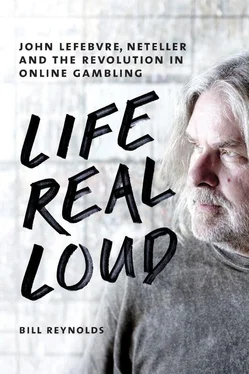Glavine’s first meeting was in Neteller’s office space, with Lefebvre and Lawrence:
Johnny was telling it like it is, like he usually does, about sports books and online gambling. Steve’s in the background, whispering to Johnny, “Don’t tell him about the sports books!” which I can hear. I didn’t know and I didn’t much care, either. They went, “What do you think?” I said, “I don’t know, let me think about it over the weekend and I’ll give you guys a call on Monday.” So I went home. About seven the next morning Steve calls and asks if I can look at something on the website. And I was like, “Uh …” So I came in and fixed the problem, which was probably somebody clicking on a page and an error coming up. ColdFusion would generate an error page, like a 404 page but its own version, and you’d have to check the log. Usually it was descriptive so you’d go and change a bit of code to get it working again. And then I fixed about ten more, and then ten more, and then I came in Sunday …
What Glavine didn’t know at this point was that the cofounders were desperately searching for someone to replace Jim Humiske and Chris Morin — two tech-savvy high school grads Natland had brought in as replacements for himself and who had both just walked out the door. They had built the all-important launch version of the Neteller website and wanted their back pay. The founders had no cash to offer either of them — if money equaled oxygen to a start-up, Neteller was gasping for air. Humiske and Morin were offered equity, but one of their dads, seeing what was happening on the news, advised them that taking equity in a dot-com was probably worthless. They came back to Lawrence and demanded the money owed, or else they were out.
It may not have been an unreasonable decision. The dot-com bubble reached its optimum size on March 10, 2000. Soon after, the NASDAQ index began its painful correction. Seven months later, half its value had vaporized. At the point when the young men left, the correction would have been excruciating to watch. Humiske went on to work at Natland’s company, Arizona Bay, and then went to China. Morin returned to Neteller, briefly, two years later.
“And then I came in Monday,” Glavine continues. “And then I came in Tuesday. And by Wednesday, I guess I was working there. After we fixed a bunch of stuff we got into building new stuff and buildings reports for Bob. They had no money — which I figured out a couple of weeks later.”
“I knew there was no money from the get-go,” says Bob Edmunds, who was also hired in August. Edmunds signed on as Neteller’s chief financial officer, but he wanted to work part-time. His wife was in graduate school and she needed help raising their two daughters at home. That was fine with the cofounders, and they welcomed aboard another senior officer in a company that had no employees.
“I remember working there for three or four days,” said Glavine, “and I said, ‘John, it seems like I’m working here.’ John says, ‘Yeah, it does, doesn’t it?’ So it’s like, ‘Well, let’s make a deal.’”
“But there was no deal,” says Edmunds. “We were working with the promise of equity, and we had no idea what that looked like.”
Glavine says,
Right, originally we made a deal where I was going to be paid fifty bucks an hour to be a consultant. I was working crazy hours the first couple of weeks, fifteen hours a day. I’m thinking, This is going to be great! After two weeks I make up this really nice invoice. It was for quite a bit of money for me at the time, several thousand. I brought it in and said, “Johnny, here’s my invoice for the first couple of weeks.” He looks at it and says, “Yeah, we really can’t pay this.”
I knew by then that there was no money in the company, so I said, “Yeah, I kind of figured that. But you know, I’m having fun so I’ll stay working for you guys as long as I can pay rent each month.” Johnny’s like, “That’s cool. Y’know, you do that and we’ll hook you up down the road.” That was it. No numbers, nothing. Just: We’ll hook you up down the road.
Johnny’s word was gold, so I said, “Sure, we’ll do that.” Every now and again I’d have to go to Steve and say, “Steve, I need a couple hundred for rent.” And Steve would cut me a personal check for $300 just so I could make rent. Late in the year, things started flying so we all sat down and made the agreements and worked out salaries.
That’s when the number of official Neteller investors grew from five to seven. Lawrence and Lefebvre kept their promise. They dangled points, around four percent each. Fortunately, Edmunds and Glavine liked their bosses and found the gig exciting and gratifying. They gambled, smartly, and became minority equity partners.
* * *
When Glavine arrived, Neteller’s website boasted a sleek new sign-up method. Lawrence and Lefebvre had paid a company called Smart Dynamics about a quarter of a million dollars in borrowed start-up cash for the system. That was okay, because it would lead them to the promised land of customers. They branded their version the “Neteller SmartCard.” The company would send new customers their own cash cards, along with instructions on how to set up and operate the card readers that were included. It looked like a cinch. Five minutes and off you go, gambling your paycheck, the kid’s back-to-school clothes budget, whatever you want.
The sign-up drive was built on FedEx credit. Edmunds says, “They were using smart cards as a PIN. When you signed up they would FedEx you a little smart card reader — that was your PIN — and twenty bucks loaded onto your smart card. The cost to the company was fifty bucks a sign-up.”
From Boulder, Colorado, someone working freelance would receive Neteller’s list and send out the packages. The reader had a small wire you were supposed to plug into a serial port at the back of your computer. The regular-sized credit card had a chip, and when you slid it into the reader a light would come on. That meant you had access to the website.
But many clients couldn’t figure out how to work the reader, and it only worked with Windows 98, which limited the customer pool. Glavine explains, “This package, it might take four or five days, or a week, to get to them. Then they’d have to set it up, which usually meant they had to call in to get the thing to work. Then they could finally make a deposit, and then send money to a merchant, and finally make a bet.”
“For a gambler!” says Edmunds. “I mean, they want it now .”
“Yeah, they want to bet a hundred on the Giants tonight,” says Glavine. “It was so clunky. I bet seventy-five percent of the smart cards we sent out, nothing ever happened.”
One of the first recommendations Glavine made to his new bosses was — news flash — you guys don’t need the Neteller SmartCard to get people to sign up. He was told they knew that, but they liked how it gave customers the impression they were getting cash on a card. Lefebvre’s position was “It gave people the idea that, ‘Look, my money is safe, it’s right here on this card.’ That’s where a lot of start-up money went — they had borrowed money to create a glorified PIN, and it rarely worked.”
And when it didn’t work, Lefebvre bore the brunt. Not that he wasn’t used to long hours on the phone by this point, but it became more intense and frustrating as more clients couldn’t find the serial port or negotiate the card/PIN or didn’t have Windows 98.
“John became the call center,” says Glavine. “He’d be walking people through this process. When it got busy, I’d start answering calls. I’d see John take his headset off, whip it down on the desk and start cursing, then pick it back up and politely go, ‘Neteller. John speaking.’”
Читать дальше












